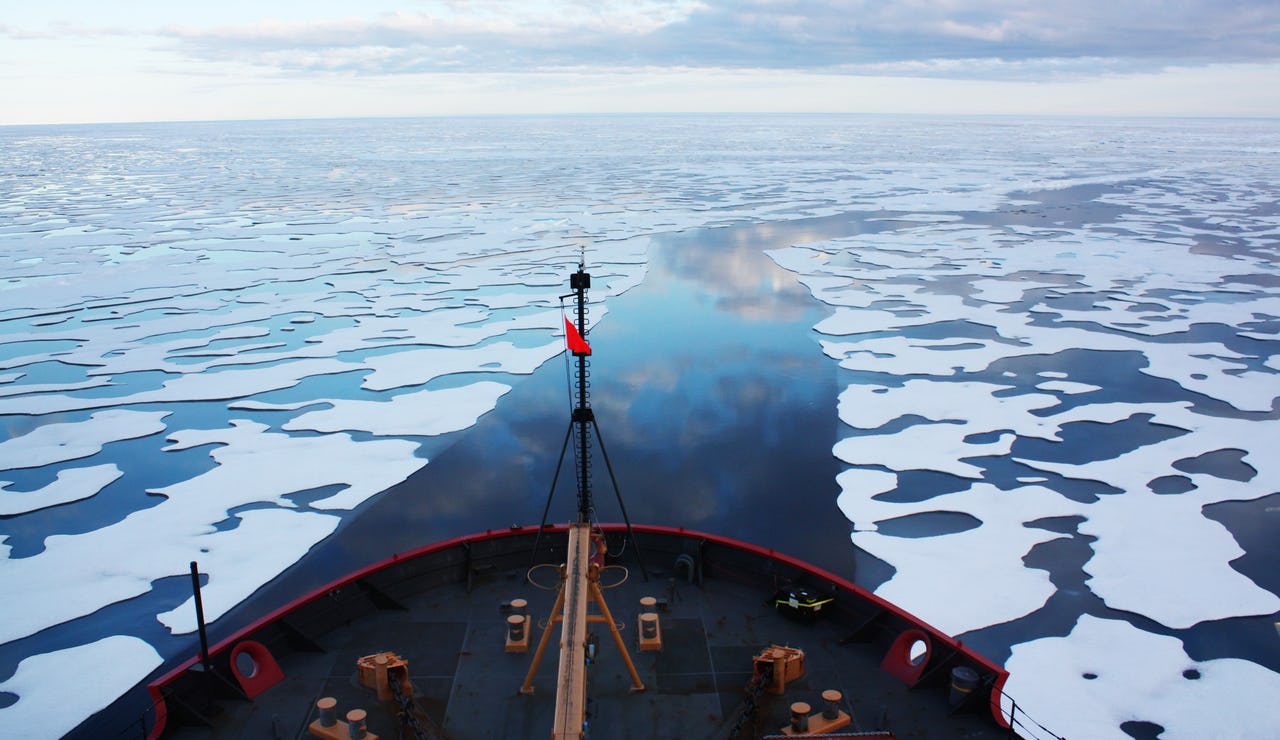What’s Next For Sustainable Development?

The U.S. Coast Guard Cutter Healy in the Beaufort Sea, northeast of Barrow, Alaska. Photo: Rawpixel
Sustainable economic development of the Arctic is progressive, human-focused, and consistently touted as the best path forward for Arctic nations. Who wouldn’t support the enthusiastic pursuit of sustainable Arctic development? Me, for one.
Sustainable economic development is “development that meets the needs of the present without compromising the ability of future generations to meet their own needs.” Sounds great. But a problem arises in deciding what is and what isn’t sustainable. Does building one oil rig in the Arctic really condemn us to a world in which future generations cannot meet their own needs? Probably not. How about two?
Because the concept of sustainability is ambiguous, governments may pursue their own notions of sustainable economic development without actually taking proactive action to combat the negative impacts of climate change. Further compounding this problem are the economic opportunities associated with rapidly melting Arctic sea ice and permafrost. Without specific rules to govern Arctic development, projects such as expanding trade routes and extracting natural resources may incentivize states to actually embrace climate change rather than fight it.
Trade Routes
As the globe continues to warm, shipping routes such as the Northwest Passage, the Northern Sea Route, and the Transpolar Sea Route are becoming increasingly accessible. By the mid century, climate models predict that these routes will be free of hazardous sea ice for over 100 days per year. Furthermore, researchers and policymakers are already anticipating the economic benefits of new trade routes in the Arctic Ocean. In 2018, for example, China drafted a white paper detailing its commitment to the sustainable development of maritime trade routes spanning the Arctic: a network it deemed the “Polar Silk Road.” Underpinning the expansion of Arctic shipping routes however, is the melting of the Arctic sea ice, which can only occur with the help of global warming. Without concrete rules that govern Arctic development, the pursuit of economic benefits associated with Arctic trade routes will motivate policymakers to neglect climate policy.
Natural Resources
An estimated 90 billion barrels of oil, 1,669 trillion cubic feet of natural gas, and 44 billion barrels of natural gas liquids remain undiscovered in the Arctic, according to a US Geological Survey assessment. Due to frigid temperatures, permafrost, and hazardous sea ice, the cost of exploiting such resources is high. However, as these barriers to development steadily subside as a direct result of global warming, the abundant resources of the Arctic will become increasingly accessible to states and companies.
Even if this development is pursued in a sustainable and conscientious manner—that is, one that safeguards Arctic wildlife, integrates the interests of Indigenous communities, and leaves sufficient resources for future generations—the reality is still present: the economic exploitation of Arctic resources is made possible only by the rise of global temperatures. States eager to access Arctic resources thus have a large economic incentive to encourage climate change instead of combating it. In the absence of specific guidelines that unite Arctic development and climate policy, it will be highly difficult to compel Arctic states to promote meaningful climate action at the expense of their own economic interests.
What can be done?
It’s clear that the vague notion of sustainable economic development will not solve our climate woes. Specific, concrete policies to fight and reverse the adverse effects of climate change should constitute the forefront of Arctic development discourse, not just sustainability.
For Arctic states, this means enacting measures that ensure that each new development project will actively combat climate change. Governments could require infrastructure projects, such as ports, schools, and roads, to utilize renewable energy sources that also provide electricity to neighboring communities. For example, they could require resource extraction projects to demonstrate net-zero emissions each year, whether that be through planting trees, restoring tropical mangrove forests, investing in renewable energy, or purchasing carbon offsets. Such measures would incorporate climate action into the very core of our development projects, guaranteeing that economic gain will never eclipse environmental wellbeing.
With Chinese President Xi Jinping’s pledge to achieve carbon neutrality by 2060 and US President Joe Biden’s plan to reach net-zero emissions by the middle of the century, it seems that the world’s biggest polluters are taking a step in the right direction. And with the world convening this November in Glasgow to draft the successor to the Paris Agreement, perhaps the international community will produce specific strategies to marry Arctic development with climate action.
Sustainable economic development is progressive, innovative, admirable, and beneficial in many ways, but it is not enough. We must also integrate concrete climate action into our Arctic development projects. Otherwise, we risk condoning global warming in the interest of sustainable development.
Coby Nguyen is a research assistant studying political science at UC Berkeley.